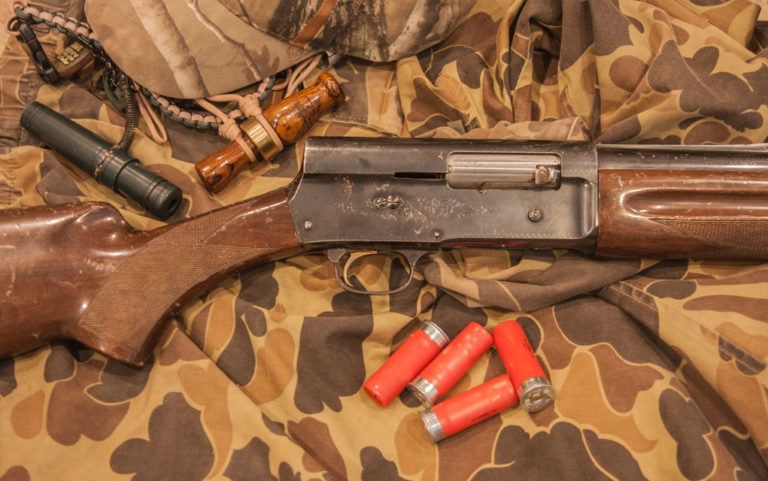
John Browning was one of the most prolific firearms designers in history, producing a number of great guns in his career. Here are nine of his best.
What are the nine finest Browning firearm designs?
- Winchester Model 1885
- Winchester Model 1894
- Browning Automatic-5
- Browning Hi-Power
- Winchester Model 1897
- M1919 Browning
- M1911
- M2 Browning
- Colt Model 1903/1908 Pocket Hammerless
- Honorable Mentions
John Moses Browning is one of the most prominent names in firearms design. He holds a place of reverence among shooters and firearms historians, and deservedly so.
Over the course of his life, Browning devoted himself almost fully to advancing firearms design. He was granted over 100 patents and is credited with developing some of the most influential and enduring guns within the past 100 years or so.
Many, if not most, of these truly innovative firearms are still in use today, either among civilian shooters or among military and police forces in the U.S and around the world. It’s been a little more than 90 years now since Browning’s passing, but his firearms legacy is certainly alive and well, and his contributions are still relevant.
As far as which of John M. Browning’s firearm designs are “best,” that’s a matter of some debate. Listed below are nine of Browning’s most timeless designs. These influential guns clearly don’t represent all of Browning’s important developments in firearms design (being more of an arbitrary “best” list), but they are a good sampling of some of his greatest works and cover categories ranging from single-shot rifles to fully automatic heavy machine guns.

Winchester Model 1885
Marking something of the beginning of John Browning’s long and productive career in firearms design, the Model 1885 was one of his earliest creations. He developed what would eventually become the 1885 at the young age of 23, and originally built the rifles by hand along with his brother before being approached by Winchester some years later, and thus beginning his longtime collaboration with that manufacturer.
Winchester engineers made a few tweaks to the design and began offering the rifle in both a Low Wall and High Wall configuration — the Low Wall being designed with an exposed hammer and intended for less powerful cartridges and the High Wall a beefier version built for more powerful cartridges.
During its heyday, the Model 1885 was believed to have one of the strongest actions available. It was a significant challenger to other popular single-shot rifles of the era from companies like Sharps and Remington.
Production on the Winchester Model 1885 ended around 1920. However, in recent years, manufacturers have begun offering modern Model 1885s for single-shot rifle fans. Uberti USA, Cimarron Firearms and, of course, Winchester are among those gun makers currently offering the 1885.

Winchester Model 1894
One of the most prolific and enduring lever-action rifles of all time, the Model 1894 first entered production the same year as its model designation, and a number of companies, including Winchester, still produce it today. Built originally to chamber and fire the metallic black powder .32-40 and .38-55 cartridges, the Model 1894 was later chambered in a number of smokeless cartridges. However, the most popular, and the one most closely associated with the rifle was the .30-30 Winchester, also known as the .30 WCF.
Over the years, the Model 1894 in .30-30 Winchester has taken countless whitetail deer. The gun is extremely lightweight, handles comfortably (especially in thicker brush) and packs adequate power for the hunter’s purposes, provided shots occur at reasonable distances.
This usefulness translated to a previously unheard of level of popularity. Well over 7 million Model 1894s have been produced since its release, and it’s still popular among Cowboy Action Shooters, as well as hunters who prefer the classic feel of a lever gun.
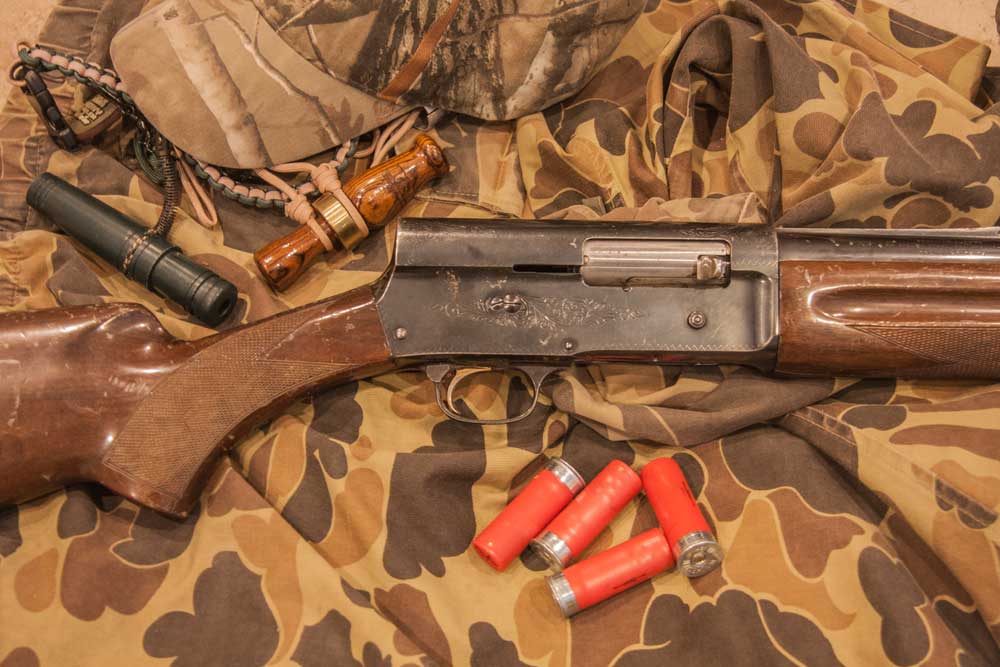
Browning Auto-5
Widely acknowledged as the first successful, mass-produced semi-automatic shotgun, the Automatic-5 design also marked a turning point for Browning, in which he ended his collaboration with Winchester. As it goes, he offered the design to Winchester first, but tried to negotiate for a royalty fee on unit sales instead of a one-time, up-front payment, as had been standard, which Winchester refused to do. He then tried to pitch the shotgun to Remington, but the manufacturer’s president died from a heart attack before he was able to do so. Eventually, Browning’s design wound up with FN Herstal of Belgium and the rest, as they say, is history.
The Auto-5 featured a unique long recoil operated design (patented by Browning in 1900) in which the barrel and bolt recoil together following the shot, then separate as the barrel begins to move forward again. At this time, the bolt stays behind to eject the spent shell, before moving forward again to chamber the new shell.
FN Herstal produced the gun for much of the 20th century, and it was also produced under license by a number of U.S. manufacturers such as Remington and Savage Arms, among others. The Auto-5 was produced from a bit after the turn of the 20th century until 1998; however, the Browning Arms Company reintroduced a version of the Auto-5, or A-5, a couple years back. This new version does use a different short-recoil operating system, though, which Browning refers to as Kinematic Drive. Both older and newer models of the “Humpback,” as the gun is endearingly called due to its distinctive high rear end on the receiver, have continued to remain popular.
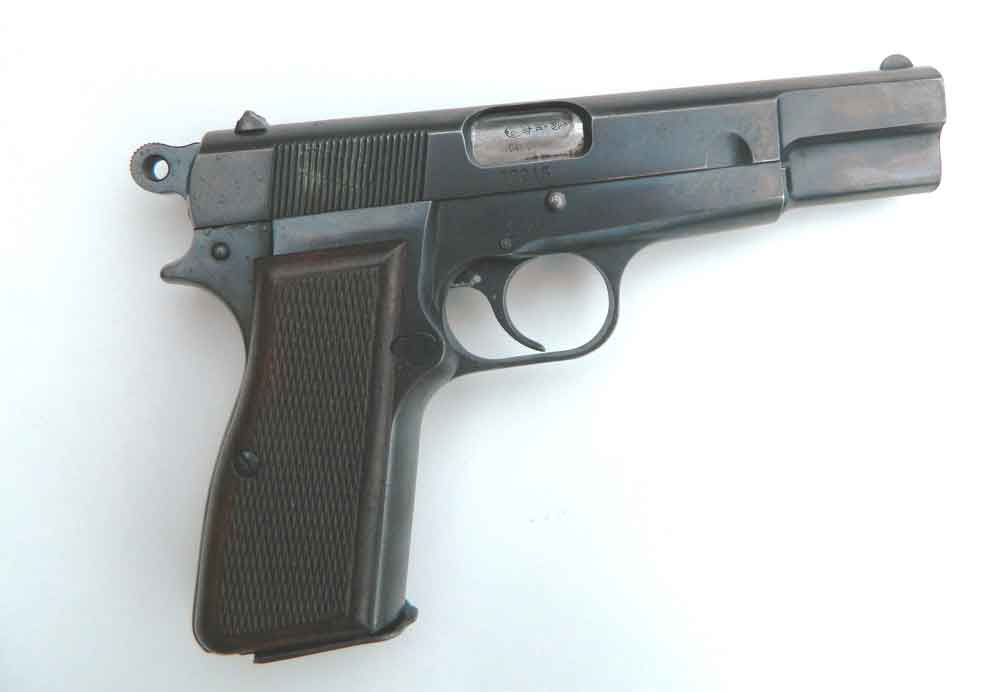
Browning Hi Power
Also known as the Model 1935, P-35, HP35, GP, GP35 and High Power, this pistol was one of Browning’s last designs. In fact, being the devoted worker that he was, it is written widely that Browning died of heart failure while working at the bench on this self-loading pistol in his son Val A. Browning’s design shop. Belgian small arms designer Dieudonne Saive completed the design.
Chambered in 9mm Luger, the Hi Power was one of the first true high-capacity pistols, able to hold 13 rounds. This was roughly twice the capacity of other common pistols, such as the M1911 and Luger P08, at the time of its introduction in 1935. Like Browning’s earlier 1911, the Hi Power was a single-action design. And it operated via a unique short-recoil mechanism.
More than 1 million Hi Powers have been produced, and the gun has seen many years of service with foreign military forces. In fact, it remains a standard sidearm with the Australian and Canadian armed forces. Of course, it’s also popular among many civilian shooters here in the U.S. as well.
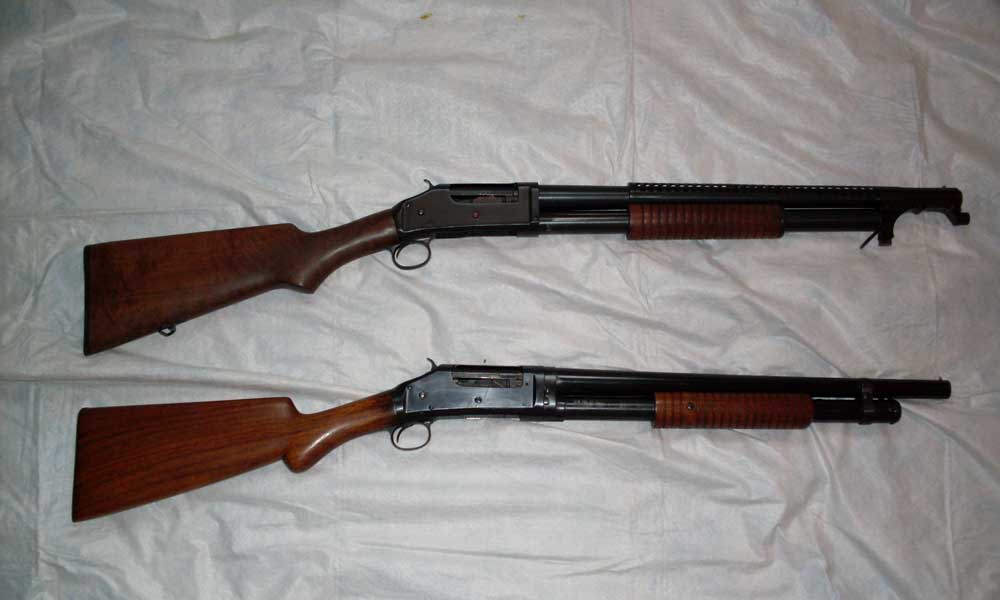
Winchester Model 1897
Just as Browning is credited with designing the first successful semi-auto shotgun, so too is it with the pump gun. The Model 1897, also known as the M97 and simply the “Trench Gun,” was based on Browning’s earlier Winchester 1893 pump-action shotgun but addressed many of the flaws in that prior design.
Produced from 1897 until 1957, the M97 was viewed as kind of the standard by which later pump-action shotguns would be judged. The 1897 introduced a takedown design in which the barrel could removed — this is now a standard feature in pump guns today — and featured an external hammer and lacked a trigger disconnector. This lack of a disconnector permitted the user to “slam fire” the gun, or simply continuously depress the trigger while working the action to fire shots if so desired.
As a historical side note, the M97 “Trench Gun” was so effective and deadly during the First World War that Germany issue a formal protest against its use, stating the use of a shotgun violated the 1907 Hague Convention. The later Winchester Model 12 would eventually supersede the Winchester Model 1897; however, it can still be found in use.

M1919 Browning
An air-cooled version of Browning’s earlier water-cooled M1917, which saw some use in World War I, the M1919 was originally similarly chambered for the .30-06 Springfield. However, it would later be adapted to a host of popular military chamberings such as 7.62×51 NATO, .303 British and others.
This belt-fed, short-recoil-operated machine gun has served in many of the U.S. conflicts — World War II, the Korean War and the Vietnam War — and many foreign militaries have also used it over the years. However, the emergence of general purpose machine guns, like the M60, and squad automatic weapons, like the M249 SAW, in later years has largely relegated the M1919 to more specialized and secondary roles, such as mounted use on vehicles.
More than 5 million M1919s were produced, making it another of Browning’s top designs.

M1911
The Browning design that Americans are likely most familiar with, the M1911, and later M1911A1, was the U.S. military’s standard sidearm until 1985, when Beretta’s M9 replaced it — a move that some still might argue against. In addition to its success as a military arm, it has been, and continues to be, wildly popular among civilian shooters. And a whole host of manufacturers ranging from large to small currently produce 1911s. In short, if there’s one Browning design that unequivocally deserves a spot on this list, it’s the 1911.
The M1911 is a short-recoil-operated single-action hammer-fired pistol. Like some of Browning’s other pistol designs, this one incorporates a grip safety, as well as a thumb-activated (for righties) safety lever on the frame.
The gun, as originally introduced, fired Browning’s .45 ACP, which he designed for the pistol. However, as we know, later 1911s and variants have been offered in a number of other popular calibers such as .380 ACP, 9mm, .38 Super and others. Coonan, Inc. even makes some to chamber the .357 Magnum, and Guncrafter Industries offers 1911s in its proprietary .50 GI for those looking for a true .50-caliber option.
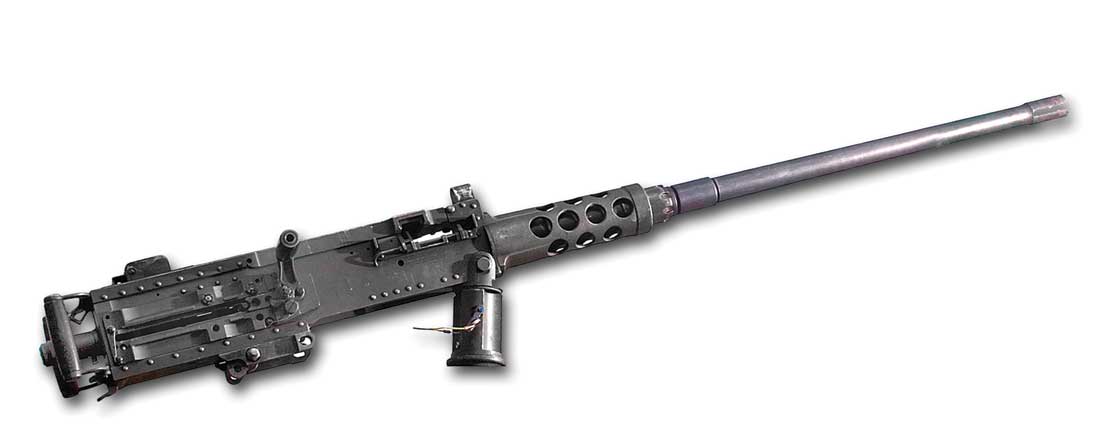
M2 Browning
Bigger and badder than Browning’s earlier M1919 machine gun, the M2 Browning was and is a potent heavy machine gun. Known by its official designation of Browning Machine Gun, Cal. .50, M2, HB, Flexible, and more colloquially as the “Ma Deuce,” this 80-plus-pound beast spits Browning’s .50 BMG (Browning Machine Gun) — designed for and named for this weapon — at a rate of 450 to 1,300 rounds per minute, depending upon the model.
The air-cooled, belt-fed M2 is a short-recoil-operated design that fires from a closed bolt. Due to its heavy weight, its predominant deployment has been as a mounted weapon on vehicles, naval vessels and aircraft and as a support weapon for troops on the ground. However, it has also been used as a sniping tool, most notably by decorated Marine Corps sniper Carlos Hathcock during Vietnam.
Like the 1911 and some of Browning’s other designs, the M2 has had a fairly long production life. Produced since 1933, the M2 Browning is still in service with the U.S. and a host of other foreign militaries.
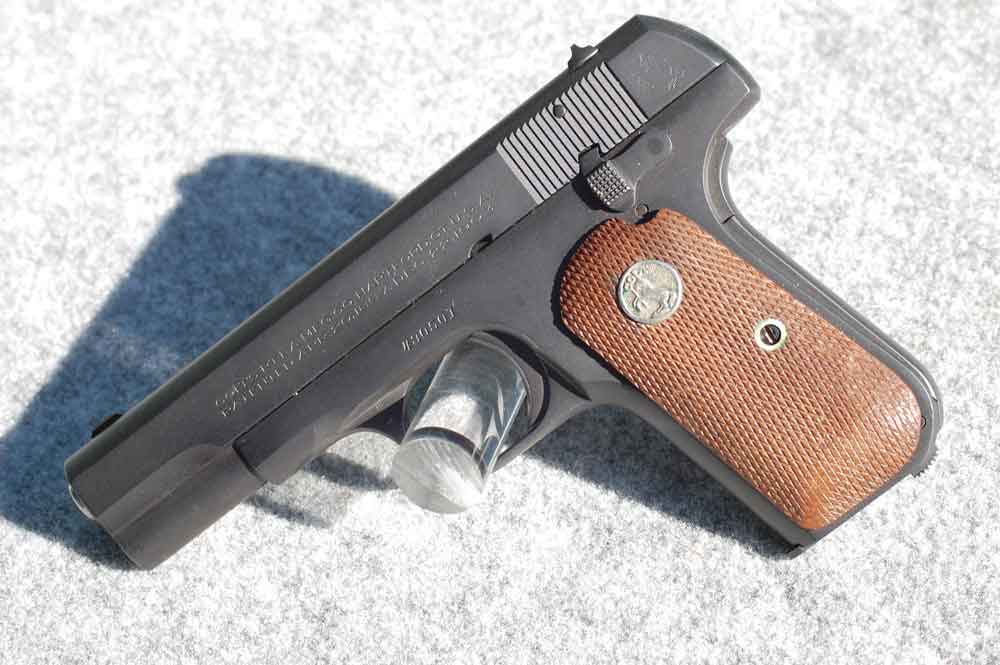
Colt Model 1903/1908 Pocket Hammerless
Sort of a culmination of some of Browning’s earlier pistol designs preceding and in the few years after the turn of the 20th century, the Colt Model 1903 Pocket Hammerless in .32 ACP — and later Model 1908 Pocket Hammerless in .380 ACP — became quite popular with the military, law enforcement and civilians. Building upon earlier designs like the M1902 and M1903 Pocket Hammer pistol, the Pocket Hammerless featured a 4-inch barrel and, despite the name, utilized a hammer that was recessed and hidden from view under the rear of the slide.
Although it was only produced from 1903 to 1945, making it one of the shorter production lives of the Browning designs listed, more than 570,000 Pocket Hammerless pistols were made. It was popular in large part due to its ability to be effectively concealed due to the hidden hammer, which was less apt to snag on clothing.
Due to its classic, elegant appearance and its interesting history, both the 1903 and 1908 Pocket Hammerless remain popular collector items. Although it is currently not produced to the degree that some other guns on this list are, a few years back, Colt did license U.S. Armament Corp. to produce a limited run of new Pocket Hammerless pistols, for those looking to buy new.

Honorable Mentions
I feel obligated to mention a few other notable John Browning firearms that I did not include above and which were right on the edge of inclusion.
The Browning Superposed, an innovative yet classically stylish over/under shotgun, was the last firearm to be designed by Browning prior to his death, and probably one of his most elegant. It had a decent production run before it was ultimately decided that it was too expensive to manufacture and thus relegated to being a specialty, limited-production item from Browning Arms Company.
The M1918 Browning Automatic Rifle (BAR) and its later variants represent another potential inclusion. The BAR saw some service in the First World War; however, its role was much more extensive in World War II and in Korea. More than 600,000 were produced.
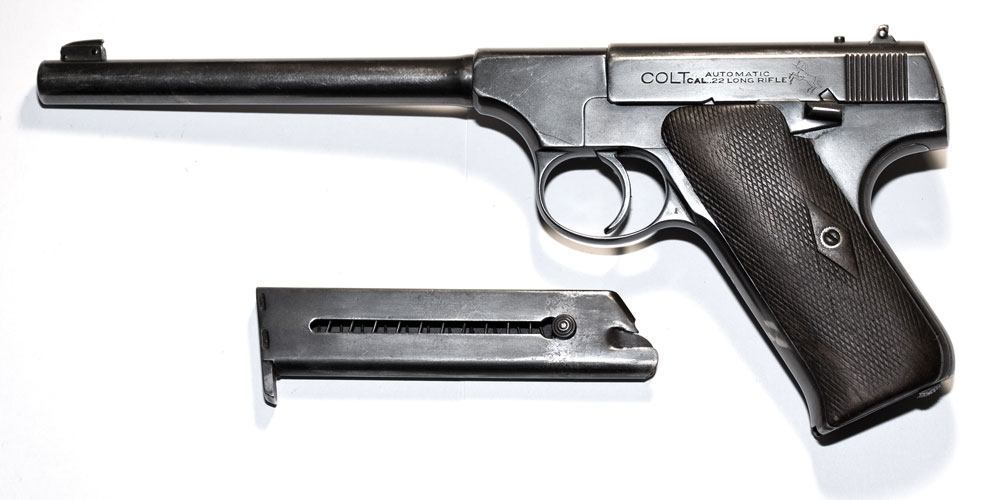
Remington’s Model 8 was another of Browning’s celebrated designs, though production figures are lower than most, if not all, of the other firearms on this list. It was, however, one of the first semi-auto rifles to see true success. At the time, most were content with their lever guns or the increasingly potent and accurate bolt-action rifles available. Produced under various names from 1906 until 1950, the Model 8 featured a long-recoil-operated design not unlike that used in Browning’s Auto-5 and was chambered in .25, .30, .32 and .35 Remington, as well as .300 Savage.
Manufactured by Colt from 1915 to 1977, the Woodsman is also deserving of a brief mention. More than 690,000 of these little semi-auto .22 pistols were produced, and in a host of different configurations with varying barrel lengths and features.
As previously mentioned, this list is by no means comprehensive. There are a number of other excellent Browning firearms designs that were not included. If one of your favorite and deserving John Browning designs has been omitted, let us know about it in the comments. We always enjoy hearing our readers’ opinions.
Corey Graff contributed to this article.
Bone Up On Browning:
- Browning Hi Power: Eulogy and Final Farewell
- Browning Buckmark Review: Timeless .22 Rimfire Pistol
- Browning A5 Shotgun: The First Autoloader
- Browning Citori: The World’s Most Popular Over/Under Shotgun
- Is There A Better Browning BLR Than The Lightweight ’81 Takedown?

Next Step: Get your FREE Printable Target Pack
Enhance your shooting precision with our 62 MOA Targets, perfect for rifles and handguns. Crafted in collaboration with Storm Tactical for accuracy and versatility.
Subscribe to the Gun Digest email newsletter and get your downloadable target pack sent straight to your inbox. Stay updated with the latest firearms info in the industry.

![Best Concealed Carry Guns In 2025 [Field Tested] Wilson Combat EDC X9S 1](https://gundigest.com/wp-content/uploads/Wilson-Combat-EDC-X9S-1-324x160.jpg)


![Best 9mm Carbine: Affordable PCCs [Tested] Ruger Carbine Shooting](https://gundigest.com/wp-content/uploads/Ruger-Carbine-Shooting-100x70.jpg)
![Best AR-15: Top Options Available Today [Field Tested] Harrington and Richardson PSA XM177E2 feature](https://gundigest.com/wp-content/uploads/Harrington-and-Richardson-PSA-XM177E2-feature-100x70.jpg)

I’ve always been a Browning design enthusiast! My first pistol was a .22 LR Browning Challenger in 1973, followed by Winchester 94 in 30/30 for deer hunting, then years later one in 45 Colt for SASS. In the 90’s I competed in IHMSA and had 2 Buckmark’s, a metallic silhouette model and a scoped hunter model. My 16 year old daughter at the time actually won the Women’s Kansas State Championship with the hunter model. I also had and cherished a 1911 .45 ACP colt that I gave to my Iraq veteran marine son-in-law on his first Christmas with us. I’ve always over the years been gun nut, a trader, seller and buyer but as I aged and the eyes went south the collection diminished. There was only one Browning Firearm however, that I could not part with and that was JMB’s first patent, a 45/70 Gov’t. 1885 high wall! My grandson will inherit this one some day. In my prime (40’s) I could hit a pop can at 150 yds. with original iron sights.
That’s the most fun you can ever have with an old caliber big bore rifle! My only regret is not buying the auto 5!
I think Browning’s X-Bolt line of rifles is outstanding for the design features and quality. I own Browning’s top-of-the-line X-Bolt Pro with stainless steel barreled action and carbon fiber stock. In 6.5 PRC it is a tack driver.
ERci B.